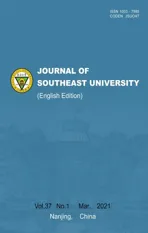Effect of carbonation-drying-wetting on durability of coral aggregate seawater concrete
2021-04-24DaBoYuHongfaMaHaiyanDouXuemeiWuZhangyuChenYan
Da Bo Yu Hongfa Ma Haiyan Dou Xuemei Wu Zhangyu Chen Yan
(1College of Harbour, Coastal and Offshore Engineering, Hohai University, Nanjing 210098, China)(2Yangtze Institute for Conservation and Development, Hohai University, Nanjing 210098, China)(3Nantong Institute of Marine and Offshore Engineering, Hohai University, Nantong 226300, China)(4Key Laboratory of Coastal Disaster and Defence of Ministry of Education, Hohai University, Nanjing 210098, China)(5Department of Civil Engineering, Nanjing University of Aeronautics and Astronautics, Nanjing 210016, China)
Abstract:Based on the drying-wetting cycles experiment and the carbonation-drying-wetting cycles experiment for coral aggregate seawater concrete (CASC) with different strength grades, the effects of carbonation-drying-wetting on the durability of CASC are studied with the surface state, mass loss rate, relative dynamic elastic modulus, ultrasonic wave velocity and cube compressive strength as indices. Results show that the mass loss rate of CASC increases gradually with the increase in cycle times in the drying-wetting and carbonation-drying-wetting cycles. The mass loss rate increases relatively slowly at the initial stage but it increases remarkably after 10 cycles. The relative dynamic elastic modulus and ultrasonic wave velocity decrease gradually with the increase in cycle times. After 6 cycles, the decrease rate of the relative dynamic elastic modulus and ultrasonic wave velocity of CASC tends to be flat and the surface is slightly damaged. Compared with the initial 28 d cube compressive strength, the cube compressive strength of CASC decreases by 8.8% to 11.0%. Drying-wetting cycles and carbonation can accelerate seawater erosion on CASC, and drying-wetting cycles result in salting-out and accelerate the destruction of concrete. Therefore, the carbonation-drying-wetting accelerates the destruction of CASC.
Key words:coral aggregate seawater concrete; drying-wetting cycles; carbonation-drying-wetting cycles; mass loss rate; relative dynamic elastic modulus; ultrasound wave velocity
High temperature, high humidity, high salinity and windy tropical marine environment will corrode the structure of coral aggregate seawater concrete (CASC)[1-3]. However, drying-wetting cycles, carbonation and Cl-erosion mainly affect the durability of marine concrete[4-7]. Drying-wetting cycles can cause the expansion and stripping of concrete. Carbonation destroys the alkaline environment of concrete, leading to steel corrosion and the failure of concrete structures[8]. Cl-in seawater causes chemical erosion on concrete and also leads to steel corrosion and concrete cracks[9]. Therefore, for marine engineering construction, it is of great engineering value and theoretical significance to study the effect of carbonation-drying-wetting on the durability of CASC.
Kakooei et al.[10]studied the steel corrosion and Cl-diffusion behavior of CASC, finding that the polarization resistance of CASC is significantly lower than that of ordinary aggregate concrete (OAC) at the same concrete mix proportion, and that the Cl-diffusion and steel corrosion rate of CASC are significantly higher than those of OAC. Yu et al.[1,11]made a field investigation of CASC structure on Xisha island, finding that the tropical marine environment has a strong corrosive effect on C15-C25 CASC structure. Its carbonation depth and steel corrosion rate are relatively high. Da et al.[12]studied the Cl-diffusion behavior of CASC, finding that the Cl-diffusion of CASC is characterized by high initial Cl-content, high surface Cl-content and high Cl-diffusion coefficient. Wang et al.[13]studied the feasibility of steel tube CASC, finding that the problem of Cl-erosion can be effectively avoided by pouring CASC into the steel tube. In addition, the calculation model of the axial compressive bearing capacity of steel tube CASC column is established. Da et al.[14-15]studied the steel corrosion behavior of CASC, explored the mechanism of steel corrosion degradation in CASC, and proposed an anti-corrosion technology of steel in CASC with low cost and high durability. In conclusion, there are no in-depth studies on the durability of CASC at present. Therefore, this paper studies the effects of carbonation-drying-wetting cycles on the durability of CASC.
Based on 14 times of the drying-wetting cycles experiment and carbonation-drying-wetting cycles experiment for CASC with different strength grades, the surface state, mass loss rate (W1), relative dynamic elastic modulus (Er), ultrasonic wave velocity (Vt) and cube compressive strength (fcu) are referred to as evaluation indices to study the effect of carbonation-drying-wetting on the durability of CASC. This serves as a reference for the research on the degradation mechanism and engineering application of CASC.
1 Experiment
1.1 Raw materials
Coral and coral sand are taken from South China Sea (see Fig.1), and the mechanical properties of coral aggregate are shown in Tab.1. P·Ⅱ 52.5 Portland cement is produced by Jiangnan Onoda Cement Co., Ltd. Grade Ⅰ fly ash (FA) is produced by the Thermal Power Plant, and S95 ground slag (SG) is produced by Jiangnan Grinding Co., Ltd. The chemical compositions of the cement and mineral admixtures are shown in Tab.2. Polycarboxylic acid high performance water-reducer is produced by Jiangsu Bote New Material Co., Ltd., in which Na2SO4is 0.18% (mass percent, the same below), Cl-is 0.01%, solid content is 30%, and the water reduction rate is 25%. Seawater is prepared in accordance with ASTM D1141-2013, containing NaCl∶Na2SO4∶MgCl2·6H2O∶KCl∶CaCl2=24.5∶4.1∶11.1∶0.7∶1.2.

Tab.1 Mechanical properties of coral aggregate

Tab.2 Chemical compositions of cement and mineral admixtures %
1.2 Specimen preparation
The size of CASC is 100 mm×100 mm×100 mm, and its mix proportion is shown in Tab.3. First, cement, coral, coral sand, SG, FA and water-reducer are dried in a mixer for 1 min, and then mixed with seawater for 3 min. The slump of concrete is measured after discharging, and then poured and shaped by vibration. After the completion of CASC, wet cloth is used to cover the surface of CASC. After 24 h, the mould is removed and the CASC is placed in the room of (20±2)℃. The drying-wetting cycles experiment and carbonation-drying-wetting cycles experiment of CASC are tested after 28 d maintenance with a straw cover and sprayed with seawater.

Tab.3 Mix proportion of CASC
1.3 Experimental method
According to EN1992-1-1 (2004),W1is 5%,Eris decreased to 60%, and the loss offcuis 25%, which are referred to as the failure standards. Based on the drying-wetting cycles experiment and carbonation-drying-wetting cycles experiment for CASC with different strength grades, the durability of CASC is studied according to the surface state,W1,Er,Vtandfcu.
1.3.1 Seawater immersion experiment
CASC is immersed in seawater relatively for 30, 78 and 120 d, and the seawater solution is changed every 28 d.
1.3.2 Drying-wetting cycles experiment
According to GB/T 50082—2009, the drying-wetting cycle system is as follows (see Tab.4).
Step 1Place the CASC in seawater solution which is at least 20 mm above its surface. The time from the beginning to the immersion end is 2 d. The seawater solution is changed every 28 d, and the temperature of the seawater solution is controlled at 25-30 ℃.
Step 2After immersion, the CASC is taken out, for air-drying in a ventilated place, and then drying in an oven. The heating is completed within 30 min, and the temperature is maintained at 50 ℃. The time from heating to cooling is 2 d.
Step 3After drying, the CASC is cooled immediately and aired in the ventilated place for 2 d.
Step 4The test lasts 84 d in total with a 6 d cycle operating 14 times. At the end of every 2 drying-wetting cycles,Er,W1,Vtandfcuare measured.
1.3.3 Carbonation-drying-wetting cycles experiment
According to GB/T 50082—2009, the carbonation-drying-wetting cycle system is as follows (see Tab.4).
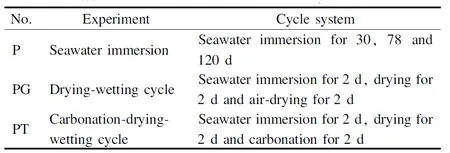
Tab.4 The cycle system of the experiment
Steps 1-2 are the same as those of the drying-wetting cycles experiment.
Step 3After drying, the CASC is cooled to room temperature. The CASC is instantly carbonized in the CCB-70A carbonation chamber. Carbonation time is 2 d, temperature is (20±3) ℃, relative humidity is (70±10)% and CO2concentration is (20±3)%.
Step 4The test lasts 84 d in total with a 6 d cycle operating for 14 times. At the end of every 2 carbonation-drying-wetting cycles,Er,W1,Vtandfcuare measured.
Step 5To test the carbonation depth, the CASC is placed on a test pressure machine, and the residual powder is scraped off after splitting. Phenolphthalein solution with a concentration of 1% is dripped on it. After 30 s, the carbonation depth is measured with a depth caliper every 10 mm along the section. The average value of the carbonation depth at each measuring point is taken as the carbonation depth of CASC.
1.3.4 Analysis method
Erof CASC is measured by NM-4B non-metallic ultrasonic testing analyzer. The calculation model[16]is as follows:
(1)
whereEris the relative dynamic elastic modulus,%;V0is the initial ultrasonic wave velocity, km/s;Vtis the ultrasonic wave velocity aftertd of erosion, km/s.
fcuof CASC is measured according to the rebound value with the concrete rebound hammer. The calculation model[17]is as follows:
fcu=24.612e0.017R
(2)
wherefcuis the cube compressive strength, MPa;Ris the rebound value.
W1of CASC is measured by an electronic balance. The calculation model is as follows:
(3)
whereW1is the mass loss rate, %;M0is the initial mass of concrete, kg;Mtis the mass of concrete aftertd of erosion, kg.
2 Results and Discussion
2.1 Drying-wetting cycles
2.1.1 Surface state
Fig.1 gives the surface state of CASC in the drying-wetting cycles. It shows that after 14 cycles, the high strength CASC does not show much damage on the surface. Erosion stripping can be seen on the surface of low strength CASC. This is mainly because many voids are produced by the remaining bubbles during the formation of concrete, and these voids are where erosion occurs, through which the seawater solution invades into the concrete. With the increase in cycle times, irregular small cracks appear on the edges and around the samples. The surface of the samples has white crystals, and the number of crystals of C50 is greater than that of C60 on the surface. This is mainly due to the rapid evaporation of water in the pore on the CASC surface during the drying-wetting cycles. The rapid crystallization of residual salt gives rise to pressure, resulting in cracks on the surface, which provides a channel for the solution to re-infiltrate into concrete[18]. During the wetting process of CASC, there is a large solution concentration difference between the surface and interior, which greatly accelerates the ion permeation rate under capillary absorption. Therefore, in the drying-wetting cycles, the erosion products of concrete are brought about continuously, and the long-term cumulative effect leads to white crystals on the surface, which eventually leads to the failure of concrete.
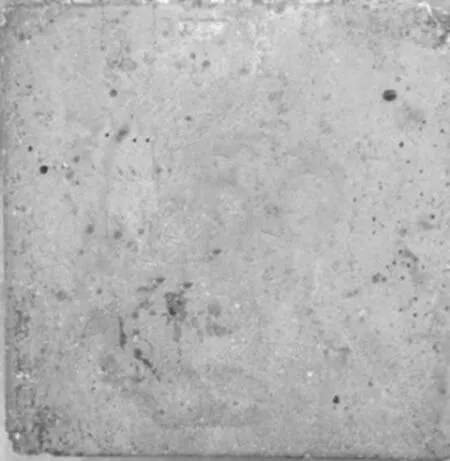
(a) (b) (c)
2.1.2 Mass loss rate
Fig.2 gives the mass loss rate (W1) of CASC in the drying-wetting cycles. It shows that in the 2nd, 4th, 6th and 8th drying-wetting cycles,W1of C65 is 0.89%, 0.90%, 1.48%, 1.63%, respectively, indicating that with the increase in cycle times,W1of C65 increases gradually and the rate relatively slows down. In the 10th, 12th and 14th drying-wetting cycles,W1of C65 is 2.22%, 3.56% and 4.59%, respectively, indicating that the growth rate ofW1at the later stage is obviously higher than that at the initial stage. The reasons are as follows: 1) During the drying-wetting cycles, the degree of hydration of CASC is increased and its internal density is gradually enhanced. 2) Various ions diffuse into the internal pores of concrete, producing plenty of products of erosion, which compact the concrete, but there are not many products and they increase slowly. With the increase in cycle times, various corrosive ions enter the pores of concrete through capillary adsorption and natural diffusion[19], accelerating the corrosion of concrete and significantly increasingW1at the later stage.
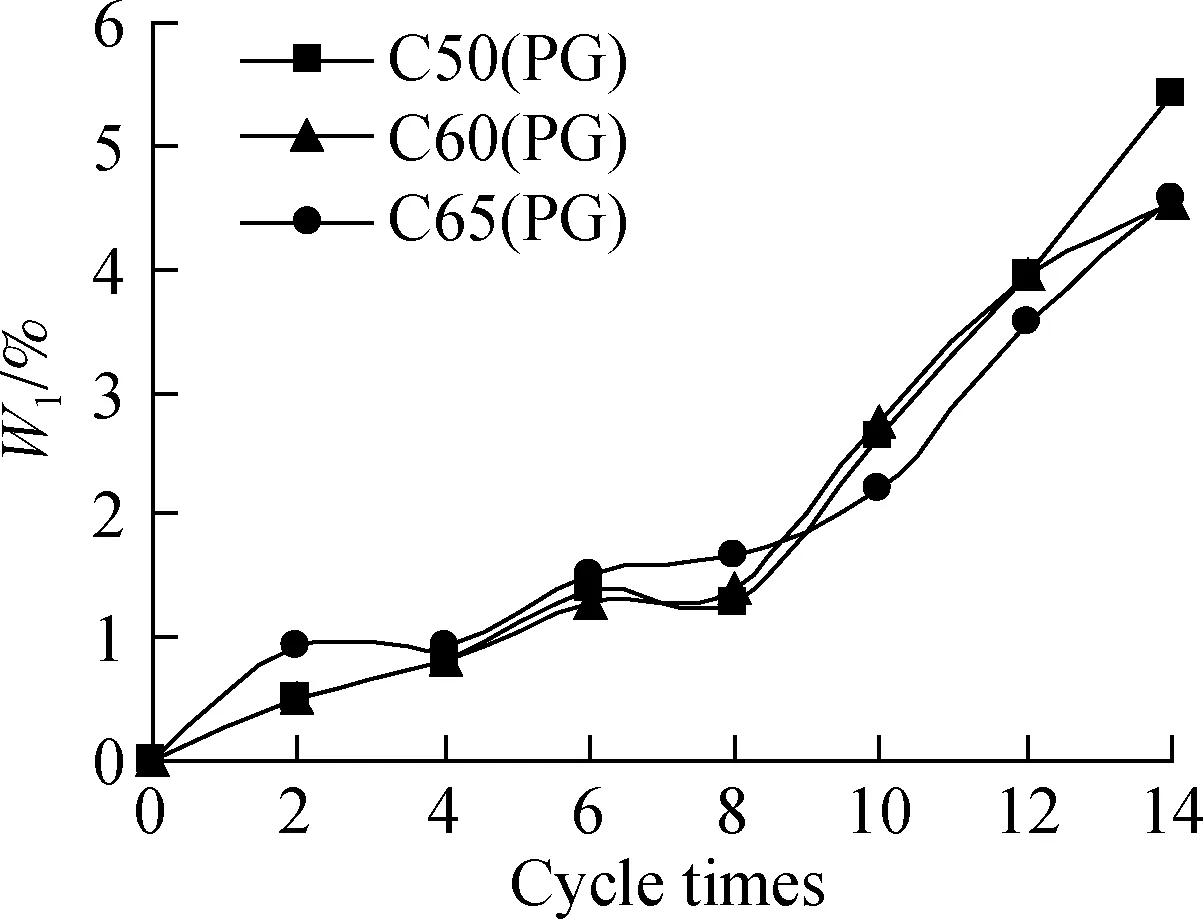
Fig.2 W1 of CASC in the drying-wetting cycles
2.1.3 Relative dynamic elastic modulus and ultrasonic wave velocity
Fig.3 gives the relative dynamic elastic modulus (Er) and ultrasonic wave velocity (Vt) of CASC in the drying-wetting cycles. It shows thatErof CASC decreases gradually with the increase in cycle times. Furthermore, for the same cycle times, the higher the strength of CASC, the greater theEr. In the drying-wetting cycles, with the increase in cycle times,Vtof CASC decreases gradually.Vtof C65 is the maximal, C60 is the in-between, and C50 is the minimal in the same cycle times, which is consistent with the rule ofEr.
In addition,in the 4th, 8th and 12th cycles,Erof C65 increases by 2.80%, 2.34% and 3.68%, respectively, compared with that of C60.Erof C60 increases by 3.55%, 2.17% and 3.95%, respectively compared with that of C50. After 14 cycles,Erof C50, C60 and C65 decreases by 29%, 26% and 26%, respectively, which does not reach the failure threshold. The reasons are as follows: In the drying-wetting cycles, the diffusion of various ions silt up in the pores of CASC, and thus the expansion stress increases, cohesion weakens, and concrete swelling and shrinkage lead to the gradual extension of cracks from inside to outside. Damage accumulates continuously and the decrease trend ofErgradually slows down.
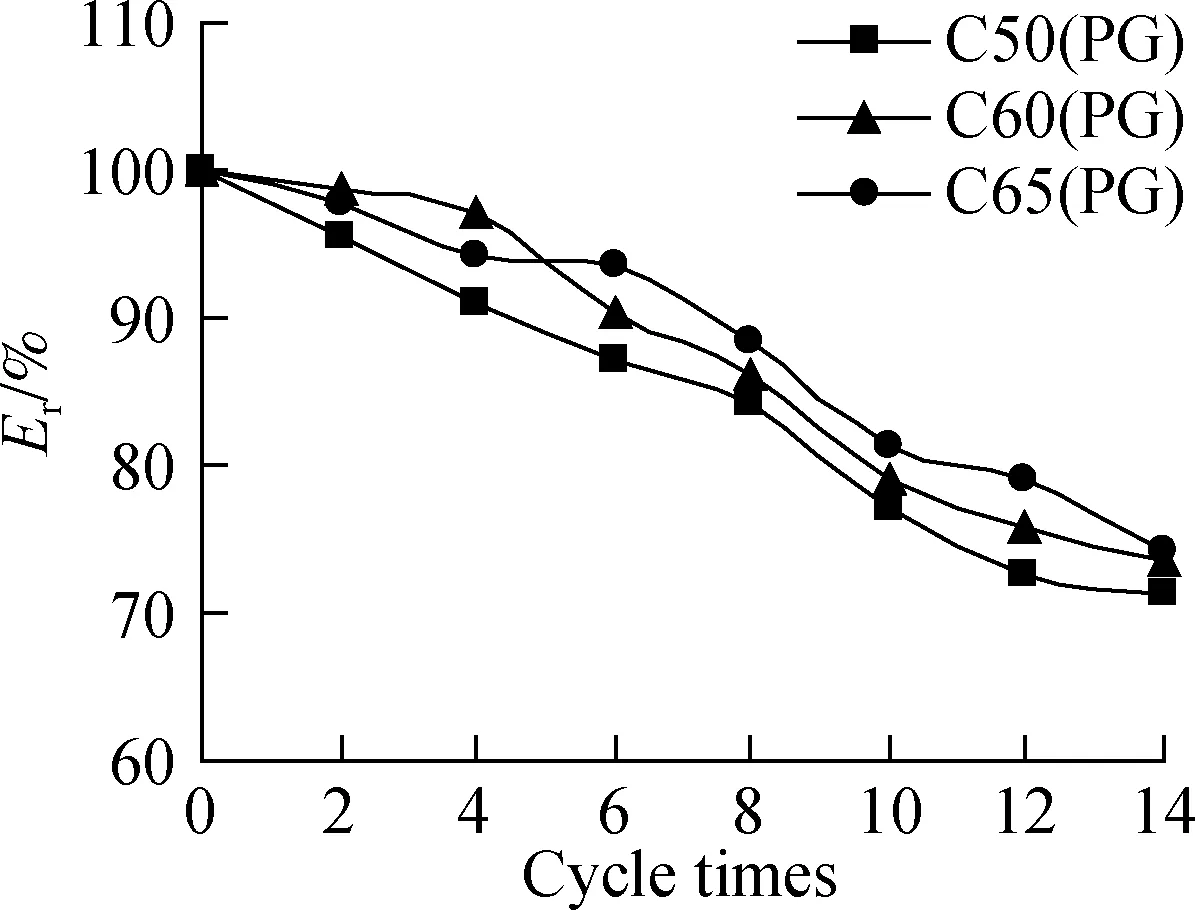
(a)
The pore structure of low strength CASC has a low compactness and high permeability, which is conducive to the growth and enrichment of erosion products, aggravating the formation of micro-cracks, and accelerating the decline rate ofEr[20].
2.1.4 Cube compressive strength
Tab.5 gives the cube compressive strength (fcu) of CASC in the drying-wetting cycles and carbonation-drying-wetting cycles, in which the curing age is 28 d. It shows thatfcuof C50, C60 and C65 decreases by 11.0%, 11.0% and 9.2%, respectively, after 14 cycles, which is consistent with the rule ofErandVt.

Tab.5 fcu of CASC in the different cycle systems
In addition,it shows thatfcuof C50, C60 and C65 decreases by 9.4%, 11.0% and 8.8%, respectively, after 14 carbonation and drying-wetting cycles, which is consistent with the rules ofErandVt. Besides,fcuof CASC in the drying-wetting cycles and carbonation and drying-wetting cycles are compared, which essentially reflects the effect of carbonation. It shows that carbonation has no obvious effect onfcuof C60 and C65, whilefcuof C50 slightly increases under carbonation.
2.2 Carbonation-drying-wetting cycles
2.2.1 Surface state
Fig.4 gives the surface state of CASC in the carbonation-drying-wetting cycles. It shows that after 14 cycles, the surface state of CASC does not change obviously, and there is no clear damage on the surface, but erosion stripping can be seen on the surfaces of CASC. With the increase in cycle times, irregular small cracks appear on the edges and around the samples. The surface of the samples has white crystals, and the crystal amount of C50 is greater than that of C60 on the surface. In addition, the carbonation depth of CASC is measured by the phenolphthalein reagent, as shown in Fig.4(d). The test results are shown in Tab.6. It can be seen that only C50 is carbonized but C60 and C65 are not. After 14 cycles, the carbonation depth of C50 CASC reaches 6.12 mm.
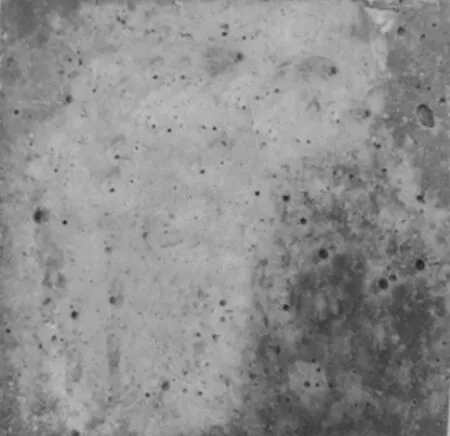
(a) (b)

Tab.6 Carbonation depth of CASC mm
2.2.2 Mass loss rate
Fig.5 givesW1of CASC in the carbonation-drying-wetting cycles. It shows that with the increase in cycle times,W1of CASC increases gradually, and the growth rate ofW1at the initial stage is relatively slow. During the 4th-10th cycle times, the growth rate ofW1increases. After 12 cycles, the growth rate ofW1tends to be flat. For the same cycle times,W1of low strength CASC is significantly higher than that of high strength CASC. Besides, in the 8th, 10th, 12th and 14th cycles,W1of C50 is 1.88%, 2.20%, 2.79% and 3.01%, respectively;W1of C60 is 1.36%, 1.51%, 2.57% and 2.87%, respectively; andW1of C60 decreases by 0.52%, 0.69%, 0.22% and 0.14%, respectively, compared with that of C50. This indicates that in the carbonation-drying-wetting cycles, the ions invading inside CASC can fill the pores, and their compactness increases gradually with the hydration and carbonation of cement. The lower the strength of CASC, the greater the permeability, and the higher the growth rate ofW1. With the increase in cycle times,W1tends to be flat or even slightly decreases, indicating that erosion products fasten the formation of micro-cracks and aggravate the damage, but the decrease ofW1is not obvious because the damage is slight. If the cycle times is prolonged, the interior of CASC will be damaged more seriously or even destroyed, andW1will decrease significantly.
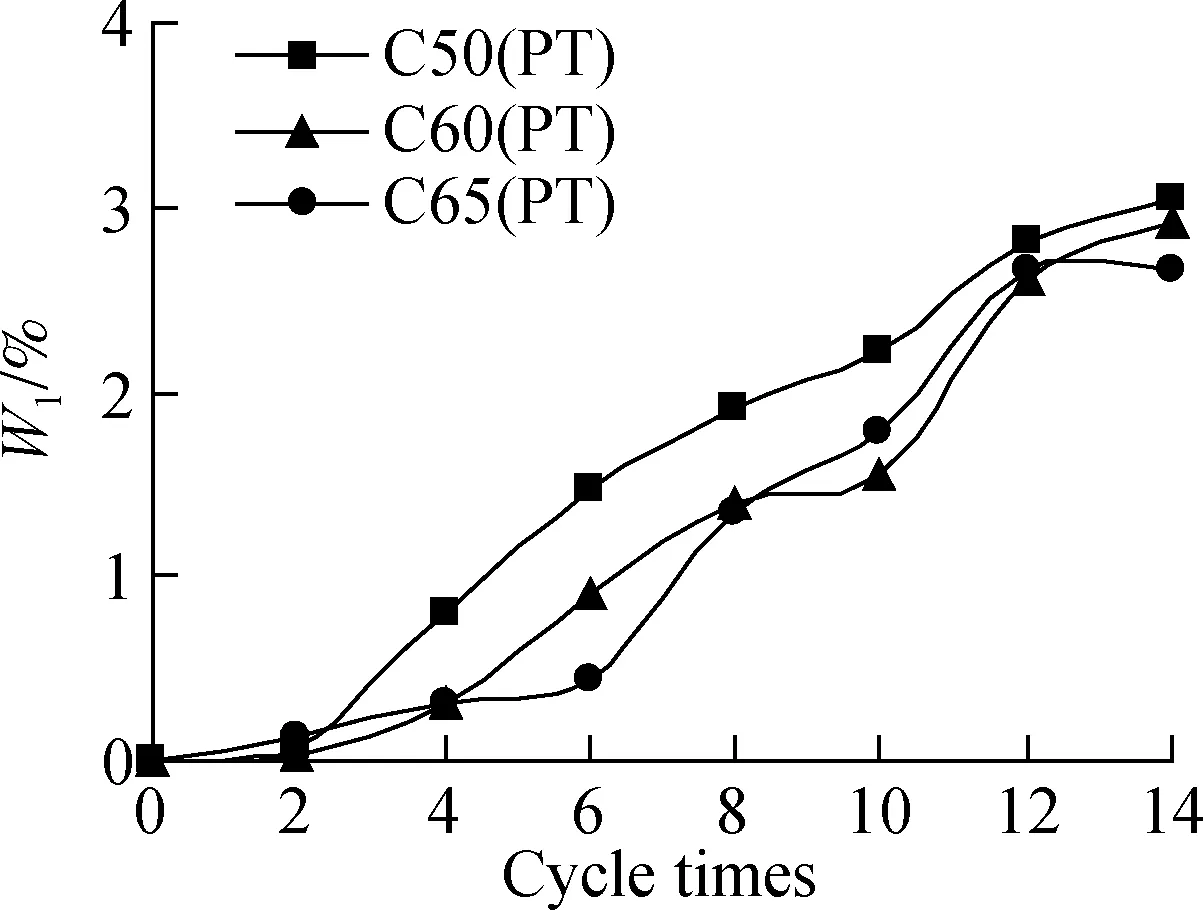
Fig.5 W1 of CASC in the carbonation-drying-wetting cycles
Fig.6 givesW1of CASC in the carbonation-drying-wetting cycles. It shows thatW1of CASC in the carbonation-drying-wetting cycles is lower than that in the drying-wetting cycles. After 10 cycles, the difference ofW1between the two cycle modes increases gradually, indicating slowdown in the weight gain of CASC at the carbonation later stage. The reasons are that in the carbonation-drying-wetting cycles,W1not only gives rise to salt erosion and physical crystallization, but also exacerbates the damage in concrete, including permeability and cracks, especially in low strength concrete[21-22].
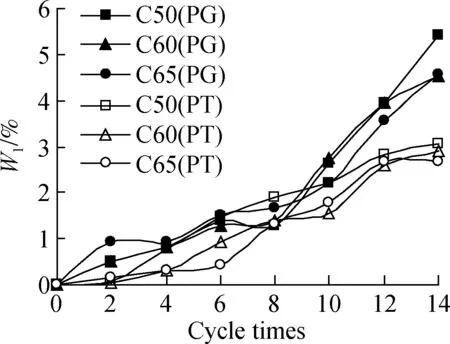
Fig.6 W1 of CASC in the different cycle systems
2.2.3 Relative dynamic elastic modulus and ultrasonic wave velocity
Fig.7 givesErandVtof CASC in the carbonation-drying-wetting cycles. It shows thatErof CASC decreases gradually with the increase in cycle times, and tends to be flat after 6 cycles. For the same cycle times,Erof CASC increases gradually with the increase in CASC strength. In addition,Vtof CASC decreases with the increase in cycle times. For the same cycle times,Vtof C65 is the maximal, C60 is the in-between, and C50 is the minimal, which is consistent with the rule ofEr. In the 4th, 8th, 10th and 14th cycles,Erof C65 is 5.92%, 7.20%, 4.06% and 5.40%, respectively, which are higher than that of C60.Erof C60 is 7.28%, 4.34%, 4.30% and 2.64%, respectively, which are higher than that of C50. After 14 cycles,Erof C50, C60 and C65 decreases by 34.72%, 32.08% and 26.68%, respectively, which does not reach the failure threshold.
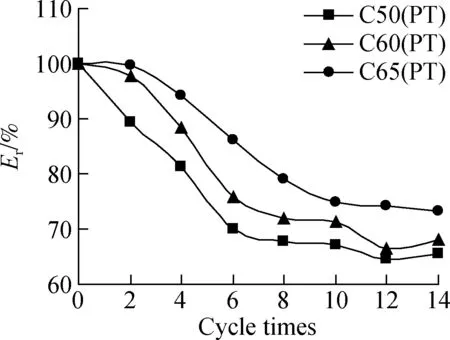
(a)
According to the mechanism of Cl-erosion[23-24], Cl-diffuses into CASC through capillary pores and cracks, and the diffusion or permeation rate is influenced by porosity, pore structure, environmental temperature, etc. In addition, the carbonation-drying-wetting cycles also provide conditions for Cl-erosion: 1) In the drying-wetting cycles, the temperature rises, the concentration of ions entering CASC increases rapidly, and the chemical reaction accelerates, which increases the number of erosion products and accelerates the damage of CASC. 2) Carbonation also changes the pore structure of CASC and makes it easy for the solution to invade CASC[25]. Therefore, the carbonation-drying-wetting cycles accelerate the destruction of CASC.
Fig.8 givesErandVtof CASC in the carbonation-drying-wetting cycles. It shows that carbonation-drying-wetting cycles accelerate the decrease ofErandVtof CASC, and aggravate damage inside CASC. In addition, C50 and C60 change clearly, but C65 does not. The reasons are that the higher the strength of CASC, the more reasonable the distribution of its micro-structure. Also, to some extent, the salt erosion is not always bad, because the products of erosion can fill the pores of CASC, which increases the solid volume of the structure, improves the internal pore structure and enhances the strength of CASC.
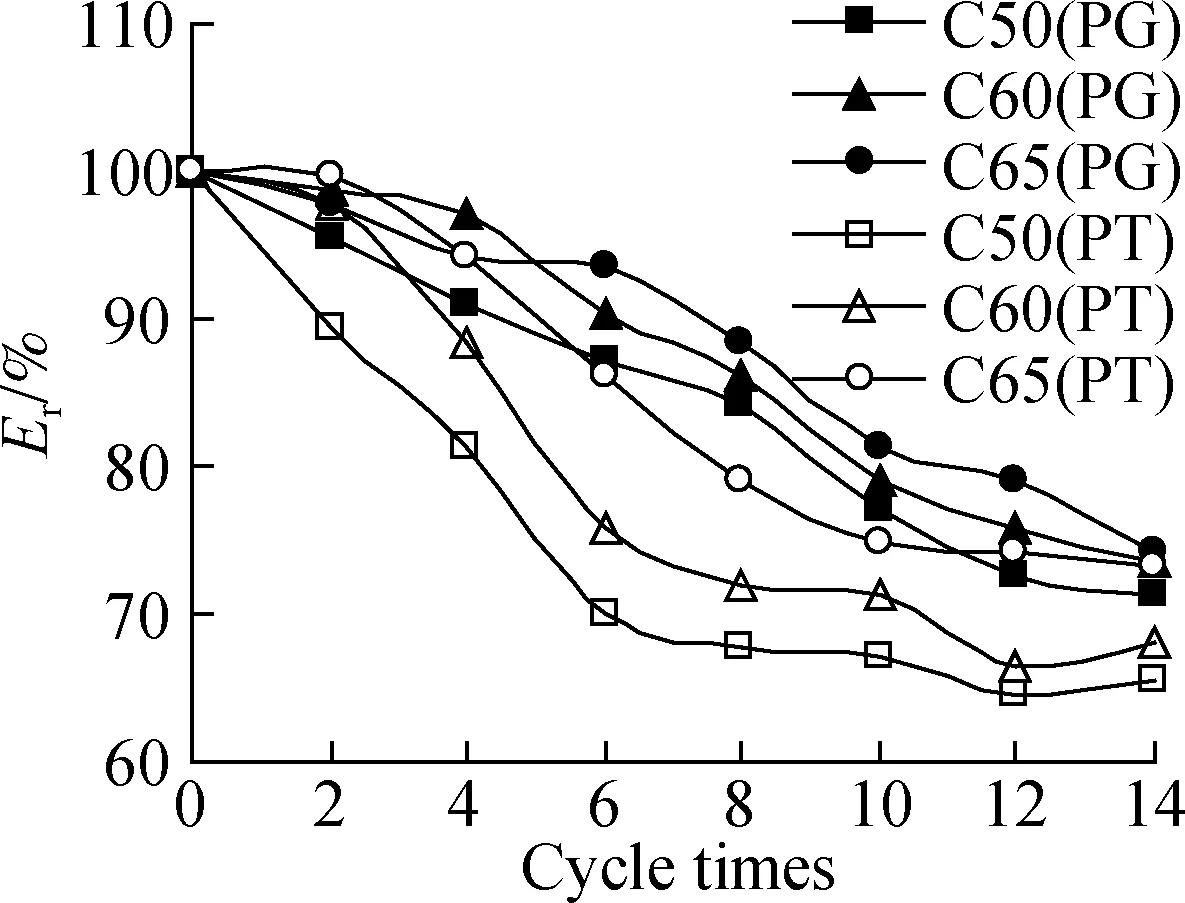
(a)
By comparing the effects of the two cycle modes onErandVt, it is shown that the rate of durability deterioration of CASC in the carbonation-drying-wetting cycles is significantly higher than that in the drying-wetting cycles, and the lower the strength of CASC, the faster the decline ofErandVt.
3 Conclusions
1) In the drying-wetting cycles and carbonation-drying-wetting cycles, with the increase in cycle times,W1of CASC increases gradually, and the growth rate ofW1at the initial stage is relatively slow. After 10 cycles,W1of CASC increases remarkably faster. In addition,W1of C65 is smaller than that of C50 after 10 cycles.
2) In the drying-wetting cycles and carbonation-drying-wetting cycles, with the increase in cycle times,ErandVtof CASC decrease gradually, and tend to be flat after 6 cycles. For the same cycle times,Vtof C65 is the maximal, C60 is the in-between, and C50 is the minimal. In the carbonation and drying-wetting cycles, the decrease inErof C50 is significantly higher than that in the drying-wetting cycles, whileErof C65 decreases by almost the same extent in the two cycle modes.
3) In the drying-wetting cycles and carbonation-drying-wetting cycles,fcuof CASC decreases. Compared with the initial 28 dfcu,fcuof CASC decreases by 8.8% to 11.0%. In the carbonation and drying-wetting cycles, only C50 is carbonized but C60 and C65 are not. After 14 cycles, the carbonation depth of C50 CASC reaches 6.12 mm.
4) Drying-wetting cycles and carbonation can accelerate seawater erosion on CASC, and drying-wetting cycles result in the salting-out and accelerate destruction of concrete. Therefore, carbonation-drying-wetting accelerates the destruction of CASC.
杂志排行
Journal of Southeast University(English Edition)的其它文章
- Analysis of bicyclist-vehicle crashat intersection area considering behavior prior to crash:A random parameter ordinal probit approach
- Coupling dimensions of human resource archetypes and organizational learning modes
- Expansion performance and self-stressing behavior of CFST columns considering concrete creep and shrinkage effect
- Fundamentals of quasigroup Hopf group-coalgebras
- Firm review revelation policy considering social ties among consumers
- Min-max fuzzy model predictive tracking control of boiler-turbine system for ultra-supercritical units
